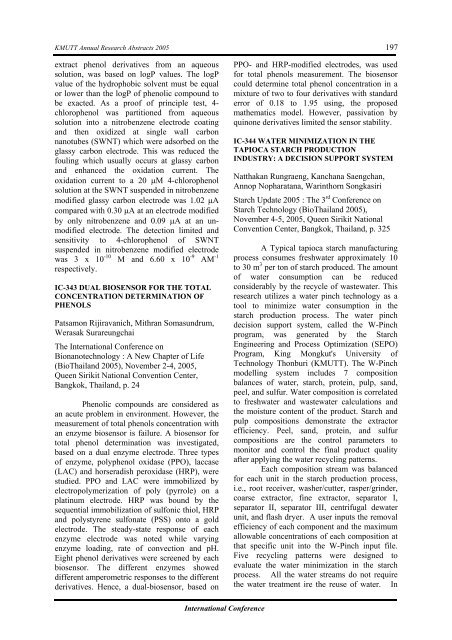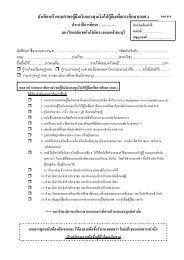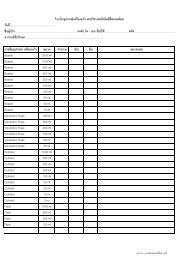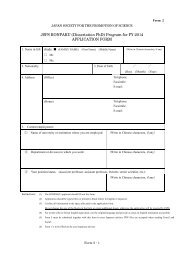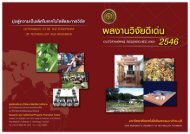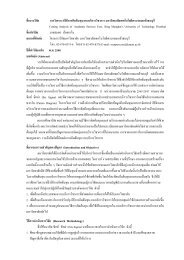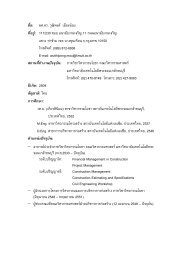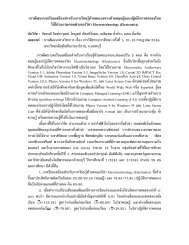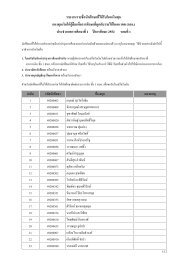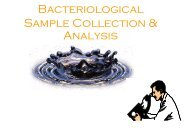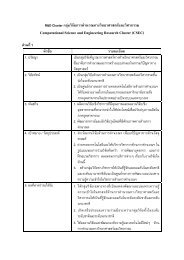You also want an ePaper? Increase the reach of your titles
YUMPU automatically turns print PDFs into web optimized ePapers that Google loves.
KMUTT Annual Research Abstracts 2005<br />
extract phenol derivatives from an aqueous<br />
solution, was based on logP values. The logP<br />
value of the hydrophobic solvent must be equal<br />
or lower than the logP of phenolic compound to<br />
be exacted. As a proof of principle test, 4-<br />
chlorophenol was partitioned from aqueous<br />
solution into a nitrobenzene electrode coating<br />
and then oxidized at single wall carbon<br />
nanotubes (SWNT) which were adsorbed on the<br />
glassy carbon electrode. This was reduced the<br />
fouling which usually occurs at glassy carbon<br />
and enhanced the oxidation current. The<br />
oxidation current to a 20 µM 4-chlorophenol<br />
solution at the SWNT suspended in nitrobenzene<br />
modified glassy carbon electrode was 1.02 µA<br />
compared with 0.30 µA at an electrode modified<br />
by only nitrobenzene and 0.09 µA at an unmodified<br />
electrode. The detection limited and<br />
sensitivity to 4-chlorophenol of SWNT<br />
suspended in nitrobenzene modified electrode<br />
was 3 x 10 -10 M and 6.60 x 10 -9 AM -1<br />
respectively.<br />
IC-343 DUAL BIOSENSOR FOR THE TOTAL<br />
CONCENTRATION DETERMINATION OF<br />
PHENOLS<br />
Patsamon Rijiravanich, Mithran Somasundrum,<br />
Werasak Surareungchai<br />
The International Conference on<br />
Bionanotechnology : A New Chapter of Life<br />
(BioThailand 2005), November 2-4, 2005,<br />
Queen Sirikit National Convention Center,<br />
Bangkok, Thailand, p. 24<br />
Phenolic compounds are considered as<br />
an acute problem in environment. However, the<br />
measurement of total phenols concentration with<br />
an enzyme biosensor is failure. A biosensor for<br />
total phenol determination was investigated,<br />
based on a dual enzyme electrode. Three types<br />
of enzyme, polyphenol oxidase (PPO), laccase<br />
(LAC) and horseradish peroxidase (HRP), were<br />
studied. PPO and LAC were immobilized by<br />
electropolymerization of poly (pyrrole) on a<br />
platinum electrode. HRP was bound by the<br />
sequential immobilization of sulfonic thiol, HRP<br />
and polystyrene sulfonate (PSS) onto a gold<br />
electrode. The steady-state response of each<br />
enzyme electrode was noted while varying<br />
enzyme loading, rate of convection and pH.<br />
Eight phenol derivatives were screened by each<br />
biosensor. The different enzymes showed<br />
different amperometric responses to the different<br />
derivatives. Hence, a dual-biosensor, based on<br />
197<br />
PPO- and HRP-modified electrodes, was used<br />
for total phenols measurement. The biosensor<br />
could determine total phenol concentration in a<br />
mixture of two to four derivatives with standard<br />
error of 0.18 to 1.95 using, the proposed<br />
mathematics model. However, passivation by<br />
quinone derivatives limited the sensor stability.<br />
IC-344 WATER MINIMIZATION IN THE<br />
TAPIOCA STARCH PRODUCTION<br />
INDUSTRY: A DECISION SUPPORT SYSTEM<br />
Natthakan Rungraeng, Kanchana Saengchan,<br />
Annop Nopharatana, Warinthorn Songkasiri<br />
Starch Update 2005 : The 3 rd Conference on<br />
Starch Technology (BioThailand 2005),<br />
November 4-5, 2005, Queen Sirikit National<br />
Convention Center, Bangkok, Thailand, p. 325<br />
A Typical tapioca starch manufacturing<br />
process consumes freshwater approximately 10<br />
to 30 m 3 per ton of starch produced. The amount<br />
of water consumption can be reduced<br />
considerably by the recycle of wastewater. This<br />
research utilizes a water pinch technology as a<br />
tool to minimize water consumption in the<br />
starch production process. The water pinch<br />
decision support system, called the W-Pinch<br />
program, was generated by the Starch<br />
Engineering and Process Optimization (SEPO)<br />
Program, King Mongkut's University of<br />
Technology Thonburi (KMUTT). The W-Pinch<br />
modelling system includes 7 composition<br />
balances of water, starch, protein, pulp, sand,<br />
peel, and sulfur. Water composition is correlated<br />
to freshwater and wastewater calculations and<br />
the moisture content of the product. Starch and<br />
pulp compositions demonstrate the extractor<br />
efficiency. Peel, sand, protein, and sulfur<br />
compositions are the control parameters to<br />
monitor and control the final product quality<br />
after applying the water recycling patterns.<br />
Each composition stream was balanced<br />
for each unit in the starch production process,<br />
i.e., root receiver, washer/cutter, rasper/grinder,<br />
coarse extractor, fine extractor, separator I,<br />
separator II, separator III, centrifugal dewater<br />
unit, and flash dryer. A user inputs the removal<br />
efficiency of each component and the maximum<br />
allowable concentrations of each composition at<br />
that specific unit into the W-Pinch input file.<br />
Five recycling patterns were designed to<br />
evaluate the water minimization in the starch<br />
process. All the water streams do not require<br />
the water treatment ire the reuse of water. In<br />
International Conference


